Analysis: Suit asks why U.S. bailout of AIG wasn’t more generous
- Share via
The trial pitting a fallen financial titan against an array of former high government luminaries provides a through-the-looking-glass view of the financial credit crisis of 2008 — a view that only makes sense on Wall Street.
In the U.S. Court of Federal Claims in Washington, D.C., Maurice R. Greenberg, the deposed head of the rescued American International Group Inc., is suing the government on his claim that the taxpayer bailout of the giant insurance company was insufficiently generous.
Although his claims were rejected in federal court in New York, he is getting a full-dress trial in the nation’s capital, complete with the compelled testimony of former high government officials — Henry M. Paulson on Monday, Timothy F. Geithner on Tuesday and Ben S. Bernanke as soon as Thursday.
That’s chiefly because, in the upside-down logic imposed by the crisis, Greenberg has a point. Other Wall Street financial institutions were treated much more generously, so why not his?
The trial, which enters its fourth day Thursday, recalls the extreme severity of a crisis that threatened world markets and AIG’s over-the-top role in it. The reverberations were so catastrophic that the only viable policy choice was to shore up the very institutions that helped bring on the crisis in the first place. The only question was: On what terms?
In 2011, Greenberg’s Starr International Co. insurance firm sued the government on behalf of shareholders claiming that federal actions during the throes of the crisis — when regulators injected $85 billion in taxpayer funds into AIG and took control of nearly 80% of its stock — amounted to an illegal taking of shareholder property.
The government eventually increased its aid to about $182 billion and its stake to 92%. In the aftermath of the Great Recession, AIG eventually repaid the debt, the government sold its stake and taxpayers ended up with a net gain of $22 billion — a return that critics called minuscule for the massive risk the government took on.
Greenberg, now 89, remains a Wall Street legend for having driven AIG to become one of the world’s largest insurers, until his ouster in 2005 amid an accounting scandal.
Under Greenberg, AIG become a leading provider of so-called credit default swaps, which are complex mortgage-backed securities that provide customers protection against defaults.
Credit default swaps were sold as a form of insurance: Buyers — including investment banking firm Goldman Sachs Group Inc. and other major U.S. and foreign banks — paid premiums to AIG, which agreed to pay in event the securities defaulted and to post cash as collateral in the event they were downgraded by Standard & Poor’s or other rating companies.
After Greenberg left, AIG accelerated the credit default swaps business, taking in relatively small insurance premiums while taking on massive risk should something go wrong in the U.S. housing market. Soon, it did.
By September 2008, with Wall Street giant Lehman Bros. in the throes of its historic bankruptcy, mortgage-related assets were crashing in value and AIG was itself on the brink, desperately fending off Goldman and other Wall Street customers, known as counter-parties, that were demanding payment on their insurance.
An AIG failure, as Geithner testified Tuesday, would have been “catastrophic,” potentially toppling AIG’s customers, in turn, and sending the real economy further into a tailspin. At the time, Geithner was head of the Federal Reserve Bank of New York and later succeeded Paulson as Treasury secretary.
In testimony Monday, Paulson acknowledged that the terms of the AIG bailout were indeed “punitive” — and deliberately so — to convince the public and congressional leaders that the company was being held accountable for the risks it had taken.
“It was important that the terms be harsh because I take moral hazard seriously,” Paulson testified.
In that case, the Greenberg lawsuit asks, why were harsh terms appropriate for one side of the transaction and not the other? Both sides took risks. AIG bet on the housing market. Its customers bet on the viability of AIG. All were in peril, Greenberg’s suit argues.
Yet the government funneled unprecedented aid to Goldman, JPMorgan Chase & Co., Citigroup Inc. and Morgan Stanley without requiring anything like the same kind of financial punishment it imposed on AIG and its shareholders.
The suit contends that the government used AIG “as a vehicle to covertly funnel billions of dollars to other preferred financial institutions, including billions of dollars to foreign entities, in a now well-documented ‘backdoor bailout’ of these financial institutions.”
Critics argue that the Greenberg suit represents the height of Wall Street arrogance.
Dennis M. Kelleher, chief executive of Better Markets Inc., a Washington nonprofit that advocates stronger financial regulation, said that how other institutions were treated is beside the point and that the Greenberg’s suit is “frivolous.”
“The only choice facing AIG was bankruptcy, total failure, a complete loss for all stockholders, and close to complete losses for all of AIG’s creditors and counter-parties — or this incredibly generous bailout from U.S. taxpayers,” Kelleher said.
“What Hank Greenberg is saying is that: ‘We should have gotten a better return from our recklessness that not only cost AIG but almost caused a second Great Depression,’” he said.
Nonetheless, the suit’s questions were pointed enough to merit a trial, at least in the view of Judge Thomas Wheeler in the federal claims court — although not in a U.S. District Court in Manhattan, where a judge dismissed a similar Greenberg suit two years ago.
The unequal treatment aside, however, the government’s blunt answer in court papers provides something of a reality check on Greenberg’s demand for $40 billion in alleged damages.
“In September 2008, AIG faced the consequences of risky, highly leveraged investments gone bad,” the government pointed out. “Neither the Constitution nor the Federal Reserve Act required American taxpayers to rescue AIG.”
Nor, the government might have added, did anyone else. But rescue AIG and its customers American taxpayers surely did, on terms that no one will admit to being happy about.
But such is the inside-out logic of the Street, where the most illuminating trial of the post-crisis era is about whether the American public, having paid dearly on many levels, will have to pay even more.
More to Read
Inside the business of entertainment
The Wide Shot brings you news, analysis and insights on everything from streaming wars to production — and what it all means for the future.
You may occasionally receive promotional content from the Los Angeles Times.








